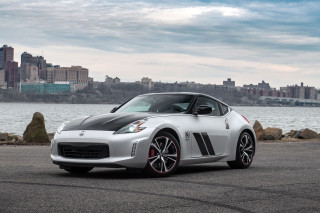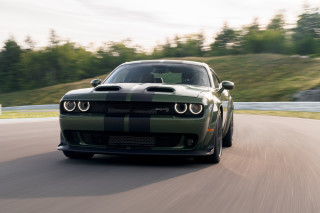Likes
- Super speed
- Super power
- Super looks
- Super options
Dislikes
- Super thirsty
- No active safety features
- Top trims cost more than $90,000
- Not practical
Buying tip
features & specs
The 2021 Dodge Challenger muscle coupe is more than a one-trick pony. It looks great while going fast, too.
The 2021 Dodge Challenger two-door coupe is in a league of its own—the old-timer’s one—but still swings a big bat.
That’s because crosstown rivals from General Motors and Ford have evolved in the 13 model years that Dodge has given us mostly the same Challenger. The Camaro and Mustang can hit for average and extra bases; the Challenger swings for the fences every time.
Its prolific speed and throwback looks are how we arrive at a 6.0 TCC Rating. Gas mileage is lousy, in case you were wondering. We don’t think you were. (Read more about how we rate cars.)
The lineup is familiar by now, but it’s also a Murderer’s Row of horsepower. Dodge offers 303-horsepower V-6-powered SXT and GT models that offer available all-wheel drive; the Challenger R/T is the gateway V-8 with 375 hp and rear-wheel drive only. The Challenger R/T Scat Pack’s 6.4-liter V-8 with 485 hp is our pick, but 6.2-liter supercharged V-8s with 717 hp, 797 hp, or 807 hp are available for the bold, brave, or just bored. The SRT Hellcat, Hellcat Redeye, and Super Stock versions of the Challenger are moments in time—high horsepower, high thirst, high cost. Whether that’s good depends on your worldview.
Every coupe gets comfy front seats for driver and front passenger with plenty of room. The rear seats are an afterthought: if carting more than one passenger is in your daily routine, consider the mechanically related Dodge Charger.
The Challenger doesn’t offer many active safety features, including automatic emergency braking. That’s a direct result of the coupe’s relatively ancient skeleton. Crash-test results are mostly good, but many do better.
Every Challenger gets at least a 7.0-inch touchscreen for infotainment with smartphone software, cloth upholstery and 18-inch wheels. Most trims get an 8.4-inch touchscreen, bigger wheels, and every option we could imagine. Power is the Challenger’s primary optional feature, and it’s prolific.
2021 Dodge Challenger Styling
Not much has changed with the Challenger in a decade. That’s a good thing.
If it ain’t broke and so on.
The 2021 Dodge Challenger doesn’t look much different from the 2011 Dodge Challenger. It’s still cool, and that’s pretty timeless. It’s an 8 for a good interior and an exterior better than that, it’s great.
The Challenger’s broad haunches and long hood are promises that it mostly delivers on. It’s fast in a straight line and looks the part. Nearly every part of the Challenger is customizable with hood scoops, graphic details, big wheels, and wide LED lights. Every coupe gets signature round headlights and beautiful, split rear LED taillights.
Inside, the Challenger cants its controls and layout toward the driver in a layout that’s simple, but effective. Dodge’s interior materials range from good to great, with small throwback nods such as houndstooth cloth, badges, and emblems.
2021 Dodge Challenger Performance
Few cars can do what the Challenger can. Fewer cost as much or less.
Performance is why you’re here and if it’s not, it should be.
The 2021 Challenger mostly sings the same tune as years before and its key is a low-octave V-8 rumble. It’s an 8 for performance based on the most popular engine configuration, which is a 5.7-liter V-8. If it were rated on what’s possible, the Challenger could be an 11.
The Challenger starts with a standard V-6 on SXT and GT models that makes 303 hp. It’s paired to an 8-speed automatic transmission with rear- or all-wheel drive. It’s enough power to send the coupe just about anywhere, but not enough to keep us from looking at what’s next.
That would be a 5.7-liter V-8 that makes 375 hp and 410 lb-ft of torque shipped to the rear wheels through a 6-speed manual or 8-speed automatic in R/T models. It lights up its rear tires and snaps off runs from 0 to 60 mph in about five seconds. Neat.
The R/T Scat Pack subs in a more powerful 6.4-liter V-8 (392 cubic inches, if you’re wondering what the badges mean) that makes 485 hp and 476 lb-ft, paired to a 6-speed manual or 8-speed automatic. It drubs 0-60 mph sprints in about four seconds and is ready for the dragstrip straight out of the box. (The 1320 version, which is available again for 2021, is even more ready with adaptive dampers, drag radials, TransBrake, and other goodies.)
From there, the Challenger’s performance speeds past superlative, toward the horizon of silly. A 6.2-liter supercharged V-8 under the hoods of SRT Hellcats spins out 717 hp and 656 lb-ft and will run to 60 mph in 3.5 seconds. Paired to an 8-speed automatic or 6-speed manual, it’s a muscle car in modern times. It’s fast, loud, and thirsty.
A 797-hp version of that same engine is found under the hoods of Redeye Hellcats and shaves a tenth off of that 0-60 mph sprint and is paired only to an 8-speed automatic. We’ve driven this version plenty; our sore necks from 707 lb-ft of thrust are proof.
The 807-hp Challenger Super Stock is king of the horsepower hill for this year. It’s best for drag-strip detail and features 18-inch wheels with street-legal drag radials and suspension components geared toward shifting its weight toward the rear.
Suspension and handling
More than two tons has no right to move this fast. Yet, here we are.
All Challengers get a four-wheel independent suspension that’s comfortable and competent in a straight line. From there, physics extracts a heavy toll that technology can mitigate—but not eliminate.
Adaptive dampers fitted to SRT Hellcats and SRT Super Stock toggle among Auto, Sport, and Track or Drag modes for increasing firmness and to shift weight toward the rear wheels. (Those dampers are available on R/T Scat Pack models as well.)
The wider Challengers are the readiest for corners, relatively speaking. They’re 2.5 inches wider than the rest of the bunch, with wider tires that grip that much more.
That said, nearly every Challenger wouldn’t blink at swapping ends faster than we can say “What’s oversteer?”
That’s why driver education and track days are critically important in any Challenger. Especially anything with an SRT badge on it.
2021 Dodge Challenger Comfort & Quality
It’s not practical, but it is pretty.
We’re not sure why the Dodge Challenger has any other seats other than the driver’s seat; it’s the only place we’d want to be.
If friends want a ride—and we’re sure many will ask for a ride—there are up to three seats available.
Starting from an average score of 5, the Challenger gets points for good front seats and good cargo capacity. It loses one for rear seats that may as well be painted on—adults won’t fit back there regularly. It’s a 6 for comfort.
The Challenger is mechanically related to the Dodge Charger, which means it has space for passengers baked in already. The front seats, which are normally covered in cloth upholstery but can be shod in leather on top trims, are big and comfy. They hug wide bodies best; smaller frames may have too much room to roam.
The rear seats are cramped and too small for adults to ride in back regularly. They’re hard to access and once aboard, it’s too dark. Dodge measures 33.1 inches of rear seat leg room but our knees beg to differ.
Behind the rear seats is a trunk that opens up 16.2 cubic feet of cargo. Who says up to 800 horsepower isn’t practical?
The Challenger reaches back to a different era of carmaking, mostly because it’s that old. We don’t mind, the interior materials are mostly good, and the cloth buckets feel durable. Optional upholstery and interior materials feel even better.
2021 Dodge Challenger Safety
The Challenger’s speed may never get old, but its safety tech sure has.
Crash-test scores for the 2021 Dodge Challenger are mostly good, but the coupe sorely lacks advanced safety features.
Federal testers gave the Challenger a five-star overall score but gave it a four-star score for front crash protection and rollover. The IIHS gave the coupe mostly “Good” scores in its tests—its highest honor—but noted “Marginal” protection in the driver-side small overlap crash test that simulates hitting a tree or light pole.
Top trims can be fitted with forward collision warnings, but automatic emergency braking can’t be added for any amount of money. Same goes for active lane control.
2021 Dodge Challenger Features
At least six trims and myriad options are available for the 2021 Challenger.
The 2021 Dodge Challenger may be one of the most customizable vehicles on the planet, aside from full-size pickup trucks. There’s just one option that’s not available at any price: automatic emergency braking. That cuts down our features score to a 7 for endless options and a good touchscreen on all versions.
There may not be enough space on the internet to delve into all of the Challenger’s configurations, so what follows is abridged.
This year, the Challenger is available in SXT, GT, R/T, R/T Scat Pack, SRT Hellcat, SRT Hellcat Redeye, and SRT Super Stock (all-wheel drive is available only on SXT and GT). Prices vary from less than $30,000 to nearly six figures. Base coupes get cloth upholstery, 18-inch wheels, a 7.0-inch touchscreen with Apple CarPlay and Android Auto compatibility, power-adjustable front seats, and all the looks.
Temptation pushes us well past those, though.
The burbling V-8 R/T Scat Pack calls our name with 20-inch wheels, more drive modes and a robust suspension setup, an 8.4-inch touchscreen for infotainment and killer looks.
The top of the pile is the new Challenger Super Stock that summons a 6.2-liter supercharged V-8 for power, 18-inch wheels (suited primarily for drag-strip use), an 8.4-inch touchscreen infotainment system, houndstooth cloth interior, and a bevy of performance upgrades. The Challenger Super Stock may be the most you can spend on a two-door Dodge, but it’s geared mostly toward bragging rights, and occasional test-and-tune nights at the local drag strip. The ultimate street Challenger is the SRT Hellcat Redeye Widebody that features the same creature comforts, but also 20-inch wheels. Softer leather hides, synthetic sueded headliner, and booming 900-watt audio systems are optional equipment for both.
2021 Dodge Challenger Fuel Economy
Gas mileage in the Challenger stinks. Were you expecting anything else?
If you’re looking for good gas mileage, you’ve missed the point. Prolific power has prolific thirst.
The 2021 Dodge Challenger 5.7-liter V-8 is most popular and the basis for our score of 3. The EPA rates those coupes at 16 mpg city, 25 highway, 19 combined on mid-grade gasoline, which is recommended. With a manual transmission, those numbers fall to 15/23/18 mpg.
Coupes equipped with a V-6 are a little better: 19/30/23 mpg with rear-wheel drive, or 18/27/21 mpg with all-wheel drive.
From there, power and gas mileage are inversely proportional. A 6.4-liter V-8 under the hoods of R/T Scat Pack models is rated around 18 mpg combined, same as the 5.7-liter V-8.
Supercharged 6.2-liter V-8s under the hoods of Hellcats and the new Super Stock spin out more than 700 hp (or 800 hp) and slug premium gas at a 16-mpg combined clip. Lower figures are possible—and likely.















































































































